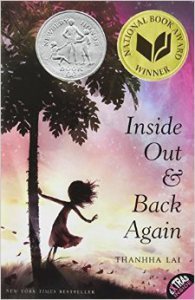National Poetry Month: Guest Post from Cordelia Jensen: Constructing an Image System for a Verse Novel
My favorite part of writing verse novels—and maybe writing in general—is image construction. I am a lateral thinker and, for me, there is no greater sense of joy than when an image flies into my brain connecting two seemingly disconnected things. In my upcoming verse novel, SKYSCRAPING, I used celestial imagery throughout the book to convey the main character’s own existential crisis, he own search for meaning in a world that suddenly feels vastly confusing. I tried hard when writing this book, not to just think about a singular image working alone on the page, but how the main character’s experience with the sky would change as she did. I believe an image standing alone is often not as strong as an image system that evolves, gathering meaning over the course of a narrative. This is the way the “prose” part of a verse novel gifts the “poetry” part of the story.

HarperCollins, Reprint Edition, January 2013.
As a creative writing teacher, when I teach imagery construction is verse novels I focus on Thanhha Lai’s middle grade Newbery Honor book, INSIDE OUT & BACK AGAIN. The imagery in this book is simple—it is written from a fourth grader’s perspective. But it is powerful in its simplicity: The image of the papaya fruit changes in the meaning as the main character herself changes. For instance, when Hà still lives in Vietnam and her innocence is intact, the papaya fruit is a beacon of hope for the future:
I vow
to rise first every morning
to stare at the dew
on the green fruit
shaped like a lightbulb.
I will be the first
to witness its ripening.
As fear infiltrates Hà’s world, the fruit remains beautiful but takes on a somewhat grotesque quality as well as Hà compares the fruit to human body parts: “five papayas the size of my head,/ a knee,/ two elbows, / and a thumb/ cling to the trunk.” There is also a sense here of Hà’s pull towards the familiar, the home and a life she knows, although this life may be quickly taken away. This is further seen in the image of the papaya being eaten: “Black seeds spill/ like clusters of eyes, / wet and crying.”
Once Hà is on the ship to America, the papaya fruit calls to her, and she longs for the fruit as much as home itself: “The first hot bite/ of freshly cooked rice, / plump and nutty, / makes me imagine / the taste of ripe papaya / although one has nothing / to do with the other.”
Once in America, Hà experiences all sorts of challenges, and the fruit is not mentioned for over a hundred pages. But by the end of the book, Hà’s longing for the faraway papaya returns; she compares her desire for the fruit to her mother’s longing for her father. Then, when her tutor finds out how much Hà misses papaya (Hà points to a picture of the papaya tree and describes the fruit hanging “in the full sun, / showing off a bundle / of fat orange piglets”), the tutor gives Hà some dried papaya as a present. At first Hà is so disappointed and angry at the difference in texture between the ripe and the dried fruit, she throws it in the trash! But in the middle of the night Hà has an idea: She retrieves the fruit and wets it to give it a more familiar taste:
The sugar has melted off
leaving
plump
moist
chewy
bites.
Hummm . . .
Not the same,
but not bad
at all.

Philomel Books, June 2015.
The reader understands—through Hà’s interaction with the papaya—that Hà has accepted her life in America although it will never be the life she had in Vietnam. Readers close the book knowing Hà will be okay.
In verse novels, unlike standard poetry, the author has the opportunity to weave imagery into plot AND, what’s more, to illuminate character change and development through image. There is a back-and-forth dialogue between the language and the plot that, if done well, can create such a satisfying, emotionally poignant story. This is certainly the case in Thanhha Lai’s book.
The key is to create an image system that is organic to the character herself as well as to the story. In SKYSCRAPING I chose celestial imagery, and in two other projects I used water and plant/food imagery to reflect the main character’s emotional state. In all of these cases the image system is also related to the plot itself. In SKYSCRAPING, Mira takes an astronomy class, and the starlessness of New York City becomes a metaphor for her feelings toward her parents’ and their betrayal. In another projects, the main character is from Myrtle Beach, so water is a big part of the way she sees the world and the cathartic climax of the book involves a freshwater creek. In another project, a novel in vignettes, food foraging is central to the plot and the plant imagery works with this point. But it is the challenge of how to create metaphors in these worlds as they relate to human psychology that I find enticing and, honestly, just fun. There’s an exercise I do with my students where I ask them to close their eyes, go back in time to the age of their character and look around. What do they see around them that might reflect their character’s emotional state? Can they find an identity crisis in an image outside the character’s window? Can they find a way for that character to sense her relationships changing as she engages in her environment?
Image systems are about showing the reader a new way to look at the world, but they can also add a layer of depth to your writing by helping you convey to your reader a character’s growth and evolution. Verse novels are a challenging form—the language and the narrative can fight each other for dominance—but in the case of image construction in particular, they can also work together to create something stronger than either one alone.

Cordelia Jensen.
Cordelia Jensen was Poet Laureate of Perry County in 2006 & 2007. She graduated with a MFA in Writing for Children & Young Adults from Vermont College of Fine Arts. Cordelia’s YA Novel in Verse, SKYSCRAPING, is forthcoming from Philomel/Penguin in June 2015. Cordelia teaches creative writing in Philadelphia, where she lives with her husband and children. Cordelia is represented by Sara Crowe of Harvey Klinger, Inc. You can find her at www.cordeliajensen.com and on Twitter @cordeliajensen








